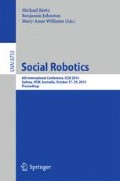Abstract
This paper presents the design and implementation of Prime, a small interactive office robot with features to support daily office activities by transporting small desktop supplies, carrying reminder notes and performing other gadget utilities. In order to create an effective inclusion of the robot in this particular workspace, the design of Prime is centered in three important aspects: functionality, aesthetics and interaction. This work is an exploratory research aimed to study the novel inclusion of small service robots in office environments and serve as a research platform to conduct human-robot interaction theories and experiments. The design and implementation of the presented robot results from an interdisciplinary work, including a survey to define Prime’s functionality and behavior in response to specific office needs, as well as its design process that comprehends sketching, scale modeling and 3D prototyping.
Access this chapter
Tax calculation will be finalised at checkout
Purchases are for personal use only
Preview
Unable to display preview. Download preview PDF.
References
Auger, J.: Living With Robots: A Speculative Design Approach. International Journal of Human-Robot Interaction 3(1), 20–42 (2014)
BenMessaoud, C., Kharrazzi, H., MacDorman, K.F.: Facilitators and barriers to adopting robotic-assisted surgery: Contextualizing the Unified Theory of Acceptance and use of Technology. PLOS One 6(1) (2011)
Bloch, P.H., Brunel, F.F., Arnold, T.J.: Individual differences in the centrality of visual product aesthetics: concept and measurement. Journal of Consumer Research 29(4), 551–565 (2003)
Breazeal, C.: Emotion and sociable humanoid robots. International Journal on Human-Computer Studies 59(1-2), 119–155 (2003)
Bruce, A., Nourbaksh, I., Simmons, R.: The role of expressiveness and attention in human–robot interaction. In: Proceedings of the 2001 AAAI Fall Symposium (2001)
Filgueiras, E., Rebelo, F., Moreira da Silva, F.: Human-computer interaction in office work: Evaluation of interaction patterns using office equipment and software during data entry and navigation. In: Robertson, M.M. (ed.) EHAWC 2011 and HCII 2011. LNCS, vol. 6779, pp. 40–48. Springer, Heidelberg (2011)
Fong, T., Nourbakhsh, I., Dautenhahn, K.: A survey of socially interactive robots. Robotics and Autonomous System 42(1), 143–166 (2003)
Forlizzi, J.: How robotic products become social products: An ethnographic study of cleaning in the home. In: Proceedings of the 2nd ACM/IEEE International Conference on Human-Robot Interaction, pp. 129–136 (2007)
Fuji Heavy Industries Ltd., http://www.fhi.co.jp/contents/pdf_56722.pdf (accessed June 14, 2014)
Fujitsu, http://pr.fujitsu.cckom/jp/news/2005/09/13.html (accessed June 14, 2014)
Goodrich, M.A., Schultz, A.C.: Human-Robot Interaction: A survey. Foundations and Trends in Human-Computer Interaction 1(3), 203–275 (2007)
Hansson, S.O.: Aesthetic Functionalism. Contemporary Aesthetics (2005) (Online)
Heerink, M., Albo-Canals, J., Valenti-Soler, M., Martinez-Martin, P., Zondag, J., Smits, C., Anisuzzaman, S.: Exploring requirements and alternative pet robots for robot assisted therapy with older adults with dementia. In: Herrmann, G., Pearson, M.J., Lenz, A., Bremner, P., Spiers, A., Leonards, U. (eds.) ICSR 2013. LNCS, vol. 8239, pp. 104–115. Springer, Heidelberg (2013)
Hegel, F.: Effects of a Robot’s Aesthetic Design on the Attribution of Social Capabilities. In: The 21st IEEE International Symposium on Robot and Human Interactive Communication, pp. 469–475 (2012)
Hekkert, P.: Design aesthetics: principles of pleasure in design. Psychology Science 48(2), 157–172 (2006)
Hoffman, G., Wendy, J.: Designing Robots with Movement in Mind. Journal of Human-Robot Interaction 3(1) (2014)
Kirby, R., et al.: Designing Robots for Long-Term Social Interaction. In: Proceedings of the IEEE/RSJ International Conference on Intelligent Robots and Systems (2005)
Kristoffersson, A., Coradeschi, S., Loutfi, A.: A Review of Mobile Robotic Telepresence. Advances in Human-Computer Interaction (2013)
Lee, M.K., et al.: Personalization in HRI: A longitudinal field experiment. In: Proceedings of the 7th ACM/IEEE International Conference on Human-Robot Interaction (2012)
Lee, M., et al.: The snackbot: documenting the design of a robot for long-term human-robot interaction. In: Proceedings of the 4th ACM/IEEE International Conference on Human Robot Interaction (2009)
Norman, D.: Design of Everyday Things. Basic Books (2013)
Osawa, H., et al.: Embodiment of an agent by anthropomorphization of a common object. Web Intelligence and Agent Systems: An International Journal (2012)
Overbeeke, C., Djajadiningrat, J., Hummels, C., Wenseen, S.: Beauty in usability: forget about ease of use! In: Green, W.S., Jordan, P.W. (eds.) Pleasure with Products: Beyond Usability (2002)
Šabanović, S., Reeder, S.M.: Designing Robots in the Wild: In situ Prototype Evaluation for a Break Management Robot. International Journal of Human-Robot Interaction (2014)
Singh, A., Young, J.E.: Animal-Inspired Human-Robot Interaction: A Robotic Tail for Communicting State. In: Proceedings of the 2012 7th ACM/IEEE International Conference on Human-Robot Interaction (2012)
Takayuki, K., et al.: An affective guide robot in a shopping mall. In: Proceedings of the 4th ACM/IEEE International Conference on Human-Robot Interaction (2009)
Tanaka, F., Cicourel, A., Movellan, J.R.: Socialization between toddlers and robots at an early childhood education center. Proceedings of the National Academy of Sciences (2007)
Venkatesh, V., et al.: User acceptance of information technology: Toward a unified view. MIS Quarterly (2003)
Author information
Authors and Affiliations
Editor information
Editors and Affiliations
Rights and permissions
Copyright information
© 2014 Springer International Publishing Switzerland
About this paper
Cite this paper
Arroyo, D., Lucho, C., Cisneros, P., Cuellar, F. (2014). Prime: Towards the Design of a Small Interactive Office Robot. In: Beetz, M., Johnston, B., Williams, MA. (eds) Social Robotics. ICSR 2014. Lecture Notes in Computer Science(), vol 8755. Springer, Cham. https://doi.org/10.1007/978-3-319-11973-1_4
Download citation
DOI: https://doi.org/10.1007/978-3-319-11973-1_4
Publisher Name: Springer, Cham
Print ISBN: 978-3-319-11972-4
Online ISBN: 978-3-319-11973-1
eBook Packages: Computer ScienceComputer Science (R0)

